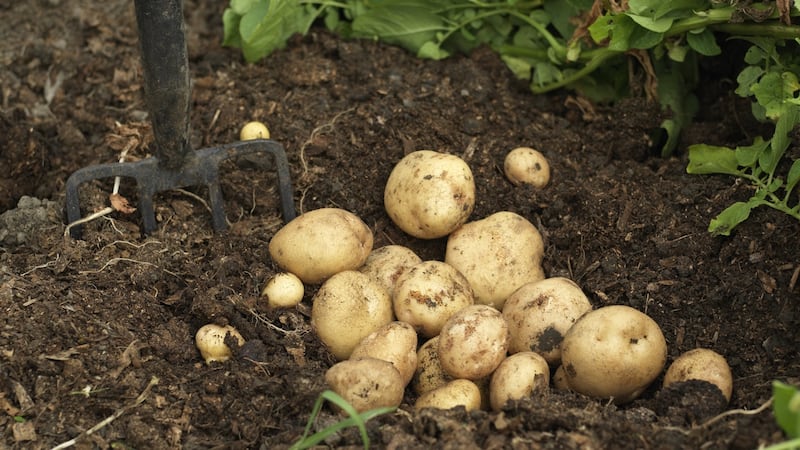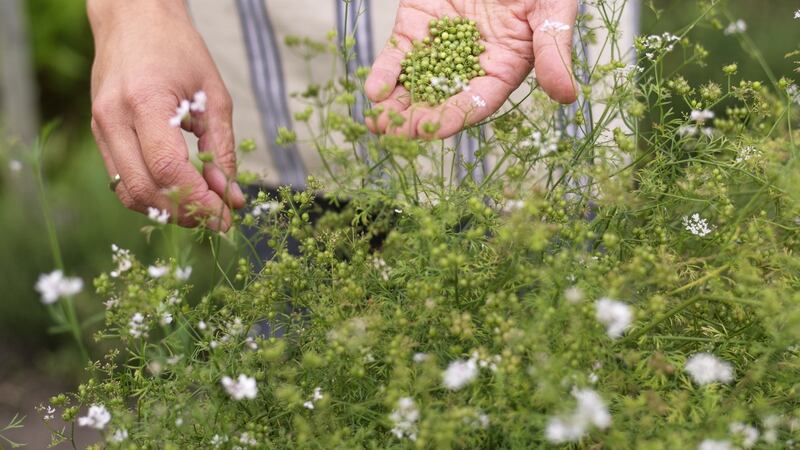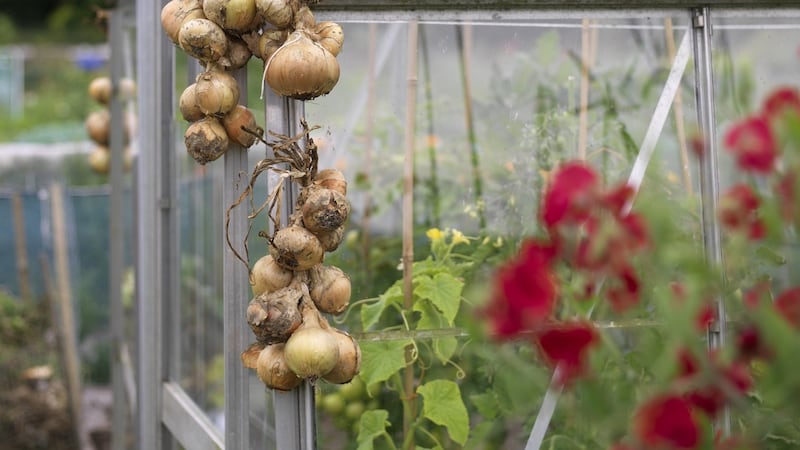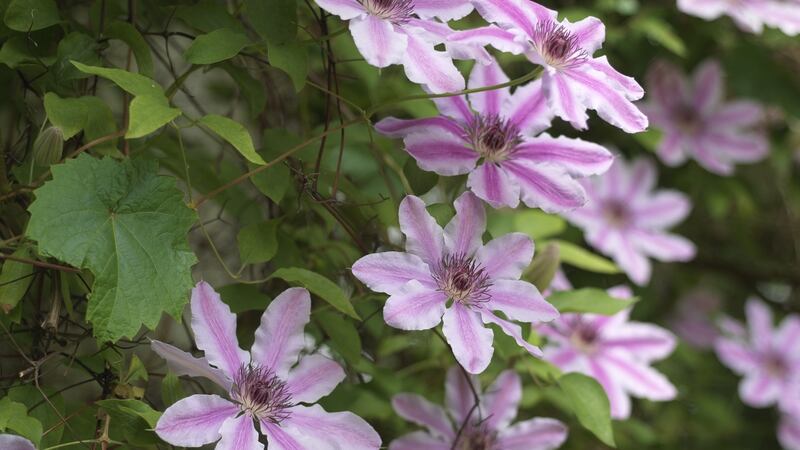Itching to get going in the garden this week? Here are ten green-fingered ways to celebrate the arrival of another growing season:
1 Plant some prataí
St Patrick’s Day traditionally marks the beginning of the Irish potato-planting season, kicking off with fast-cropping “first early” varieties such as ‘Casablanca’, ‘Colleen’, ‘Orla’, ‘Red Duke of York, and ‘Lady Christl’, seed tubers of which are available from all good Irish garden centres.
These should be planted (ideally already chitted) into a sunny, open spot and a weed-free, fertile, moisture-retentive but free-draining soil enriched with plenty of well-rotted manure or garden compost.
Potatoes can also be grown in large buckets/tubs or even strong black plastic bags. First-early varieties should be planted at a spacing of 25cm between tubers and 50cm between rows, and at a depth of 15cm. To protect emerging foliage against damaging late frosts, cover planted tubers with horticultural fleece, making sure to secure the latter against strong winds.

In gardens where soil conditions are still waterlogged as a result of February’s record rainfall, it’s best to hold off planting seed potatoes until conditions improve but if you have space in a glasshouse or polytunnel, you can plant them now under cover for an extra early crop.
2 Start planning for some sizzling summer colour
This is the perfect time of year to pot up the tubers, bulbs, rhizomes or dormant root systems of certain kinds of tender summer-flowering perennials such as dahlia, begonia, gladiolus, hedychium and canna (all of which are available from good Irish garden centres at this time of year) to start them into early growth under the protective cover of a frost-free glasshouse, polytunnel or sunny conservatory/porch.

These dramatically ornamental plants can then be moved out into the garden/ outdoor containers in late spring/early summer after all risk of frost has passed to give many months of interest.
3 Dress those pots
Plants growing permanently in containers slowly run out of key nutrients unless replenished at least once a year, a simple matter of gently scraping off the top 5cm layer of spent compost and replacing it with fresh compost plus a sprinkle of organic slow-release fertiliser.
This is also a great time to repot any perennials/shrubs that have grown too large for their existing containers or that have been growing in the same container for many years. If you can’t use a bigger pot, then gently remove about a third of the spent compost and lightly trim back the root-ball before repotting using a fresh, good-quality John Innes potting compost.
4 Sow some herbs
While it’s still too early to sow seed directly outdoors, many kinds of annual herbs can be raised from seed sown under cover at this time of year including coriander, basil, chervil and dill.
For best results make sure to use a good quality seed compost, sow sparsely, lightly cover the freshly-sown seed with compost and vermiculite, and then bottom-soak the pot/seed tray up to its waist in tepid water for a couple of hours before covering it with a plastic lid or clear plastic bag and placing it on a heated propagator or bright windowsill in a warm room.

Once you see obvious signs of germination, remove the pot/seed tray from the heated propagator and take off the lid/bag. Bear in mind that some herbs – examples include coriander and dill – dislike being pricked out/transplanted as young seedlings, so space seed 2cm apart in pots and allow the seedlings to grow on.
Others – for example chervil –need light to successfully germinate so surface-sow and then just barely cover the freshly sown seed with a sprinkle of fine-grade vermiculite. All seedlings need really good natural light levels to grow well so give them brightest spot you can.
5 Divide those perennials
Mid-March is an excellent time to lift and divide old, overgrown clumps of many kinds of perennials both as a means of rejuvenating the plants as well as to propagate from them; just one established clump can often be divided into 4-6 smaller sections and replanted in the garden or potted on to give to friends or your local garden club.
Start by using a spade to lift individual clumps out of the ground and then use either the spade, a sharp knife or what’s known as the double-fork method (two garden forks stuck back to back into the centre of the clump so that their tines intertwine, after which the handles are rocked gently back and forward) to separate it into sections.
These should be either swiftly replanted or potted on and then watered to encourage them to quickly establish. Examples of perennials suitable for spring division include stachys, monarda, phlox, hosta, hemerocallis, heuchera, helianthus, astrantia, delphinium and geranium as well as many species of ornamental grasses.
6 Weed, weed, weed
Catch weeds now while they’re young and you’ll save yourself much blood, sweat and tears as well as precious time in the months ahead. Use a sharp oscillating hoe (available from fruithillfarm.com) to slice them away or in the case of more established perennial weeds with deep root systems such as ground elder, dock and scutch, use a garden fork, trowel or Hori-Hori knife to excavate them from the ground.
To prevent fresh weed seedlings from germinating, spread a shallow mulch of well-rotted manure, garden compost or one of the commercially-produced organic mulches available such as Enrich (enrich.ie) or Gee-Up (geeup.ie) both of which are composted to high-enough temperatures to kill any weed seeds and plant pathogens.
7 Plant a rose
Edible, beautiful and often deeply perfumed, few garden flowers can beat the rose for impact as well as versatility. At this time of year you can buy roses as either bare-root plants (but bear in mind that the bare root season is soon coming to an end) or as container-grown specimens from good garden centres and specialist nurseries such as Cork-based McNamara Rose Nursery (087-1415739).
There's a wealth of wonderful varieties available to gardeners; modern classics include the pale apricot/pink repeat-flowering climber Rosa 'Penny Lane', the oh-so-fashionable, milk-chocolate coloured floribunda Rosa 'Koko Loko' and the golden bloomed, repeat-flowering shrub rose known as Rosa 'Graham 'Thomas'.
8 Sow some hardy, summer-flowering annuals
Just a few packets of seed sown this month into pots/trays under cover of a glasshouse, polytunnel, a sunny porch or a bright windowsill will quickly give you oodles of young plants to fill gaps in a border, grow on in containers or to stock your own cut flower patch.
Alternatively, if your garden is a sheltered, mild one with free-draining soil, you can sow seed directly into the ground at this time of year as long as it’s weed-free and well prepared (just make sure to protect emerging seedlings from slug damage).
Examples of hardy annuals that can be sown include cornflowers, ammi, nigella, gypsophila, orlaya, cerinthe, convolvulus, cynoglossum, consolida (larkspur) and scabious. Recommended seed suppliers include seedaholic.com and all good garden centres. Follow general sowing instructions as given above for herbs, pricking young seedlings raised under cover into individual cell trays/ liners/small pots for planting into their permanent positions later this spring.
9 Love your onions?
Mid-March is a great time to plant both onions and shallots as sets (baby bulbs) into weed-free, fertile, very free-draining ground in a sunny spot in the allotment or garden, making sure to use only firm, blemish- free sets that aren’t yet showing any new shoots or roots to avoid the risk of disease.
To boost soil fertility, rake in a little well-rotted manure or garden compost while they’ll also appreciate a sprinkle of potash-rich wood ash or powdered seaweed. Make sure to gently firm the soil down with a wooden board before planting as both of these members of the allium family struggle to establish their root systems in loose soil.

Plant to a depth where the upper tip of each set is above the soil, spacing them 10cm apart in rows 25cm apart. Just as for early potatoes (see above), it’s a good idea to cover the newly-planted sets with fleece to protect them against spring frosts which can cause them to bolt.
10 Cover that ugly wall or fence
March is an excellent time of the year to plant clematis, one of the most ornamental and versatile genus of garden climbers with a huge range of species/varieties available including some that bloom in spring, summer, autumn and even winter.
Examples include varieties of the spring-flowering, shade-tolerant Clematis alpina with its dainty bell-shaped flowers, the showy, early summer-flowering Clematis ‘Nelly Moser (very large, candy pink and white flowers) and varieties of the late summer/early autumn flowering, shade-tolerant Clematis viticella such as ‘Etoile Violette’ and scarlet-flowered ‘Madame Julia Correvon’.


All clematis should be planted deeply into a fertile, free-draining soil enriched with plenty of well-rotted organic matter and will require some form of support. When growing against a wall or fence, plant the root-ball 30cm out from it and water generously before mulching to conserve moisture.















